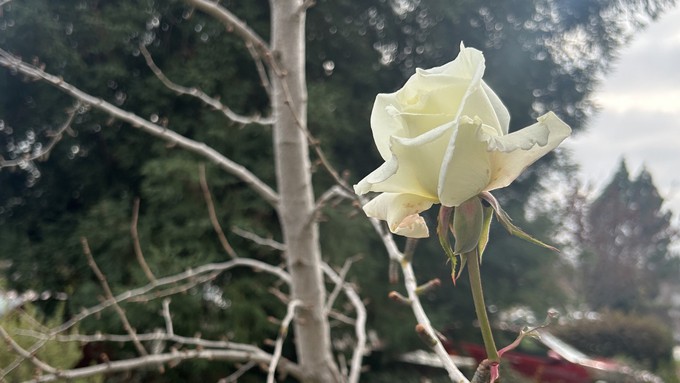
Storms take a break over Christmas weekend, but keep umbrella close

Rose growers may still have a winter rose or two, such as this Fountain Square hybrid tea rose, but it's time to start pruning the dormant plants. Kathy Morrison
It looks like Mother Nature will give us a break over this long Christmas weekend with dry weather – better for driving and for gardening (and for delivering gifts).
But more storms appear to be on the way, arriving as soon as Wednesday. According to the National Weather Service, Sacramento can expect some more wet weather, sooner than later. How much remains uncertain.
“Active weather pattern returns the middle of next week, bringing the potential for widespread rain and mountain snow,”the NWS Sacramento office posted Saturday.
Exact timing of this next round of storms is uncertain, says the weather service, noting that the weather pattern is “unsettled.” Expect a quick hit of rain Wednesday and Thursday, followed by more stormy weather right into the New Year.
There’s still a lot of moisture in the ground, and that contributes to patchy fog every morning before the rain arrives. Overnight lows are staying relatively warm, dipping to about 40 degrees. Once the fog clears, daytime highs will edge close to 60 degrees.
Make the most of time between storms – and work off some of those holiday calories. Get outside and get to work.
* Prune, prune, prune. Now is the time to cut back most deciduous trees and shrubs. The exceptions are spring-flowering shrubs such as lilacs.
* Now is the time to prune fruit trees. Clean up leaves and debris around the trees to prevent the spread of disease.
* Prune roses, even if they’re still trying to bloom. Strip off any remaining leaves, so the bush will be able to put out new growth in early spring.
* Clean up leaves and debris around your newly pruned roses and shrubs. Put down fresh mulch or bark to keep roots cozy.
* When it’s too wet to get outside, browse through seed catalogs and start making plans for spring and summer.
* Plant bare-root roses, trees and shrubs. If your ground seems saturated, consider planting your garden additions in large black plastic pots. The black plastic will warm up faster than the ground soil and give roots a healthy start. Then transplant the new addition (rootball and all) into the ground in April as the weather warms.
* Transplant pansies, violas, calendulas, English daisies, snapdragons and fairy primroses.
* In the vegetable garden, plant fava beans, head lettuce, mustard, onion sets, radicchio and radishes.
* Plant bare-root asparagus and root divisions of rhubarb (but not in soggy soil).
* In the bulb department, plant callas, anemones, ranunculus and gladiolus for bloom from late spring into summer.
Comments
0 comments have been posted.Sacramento Digs Gardening to your inbox.
Sites We Like
Garden Checklist for week of May 5
Survey your garden after the May 4 rainstorm. Heavy rain and gusty winds can break the neck of large flowers such as roses. Also:
* Keep an eye on new transplants or seedlings; they could take a pounding from the rain.
* Watch out for powdery mildew. Warmth following moist conditions can cause this fungal disease to “bloom,” too. If you see a leaf that looks like it’s dusted with powdered sugar, snip it off.
* After the storm, start setting out tomato transplants, but wait on the peppers and eggplants (they want warmer nights). Pinch off any flowers on new transplants to make them concentrate on establishing roots instead of setting premature fruit.
* Trim dead flowers but not leaves from spring-flowering bulbs such as daffodils and tulips. Those leaves gather energy to create next year's flowers. Also, give the bulbs a fertilizer boost after bloom.
* Pinch chrysanthemums back to 12 inches for fall flowers. Cut old stems to the ground.
* Mulch around plants to conserve moisture and control weeds.
* From seed, plant beans, beets, cantaloupes, carrots, corn, cucumbers, melons, pumpkins, radishes and squash.
* Plant onion sets.
* In the flower garden, plant seeds for asters, cosmos, celosia, marigolds, salvia, sunflowers and zinnias. Transplant petunias, zinnias, geraniums and other summer bloomers.
* Plant perennials and dahlia tubers for summer bloom.
* Don’t wait; plant summer bulbs, such as gladiolus and tuberous begonias.
* Harvest cabbage, lettuce, peas and green onions.